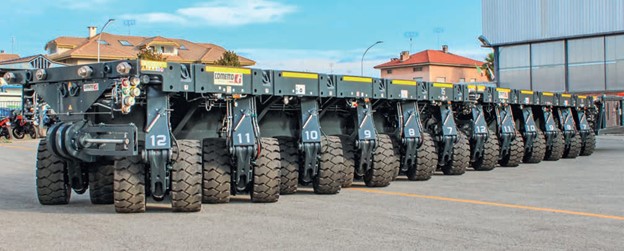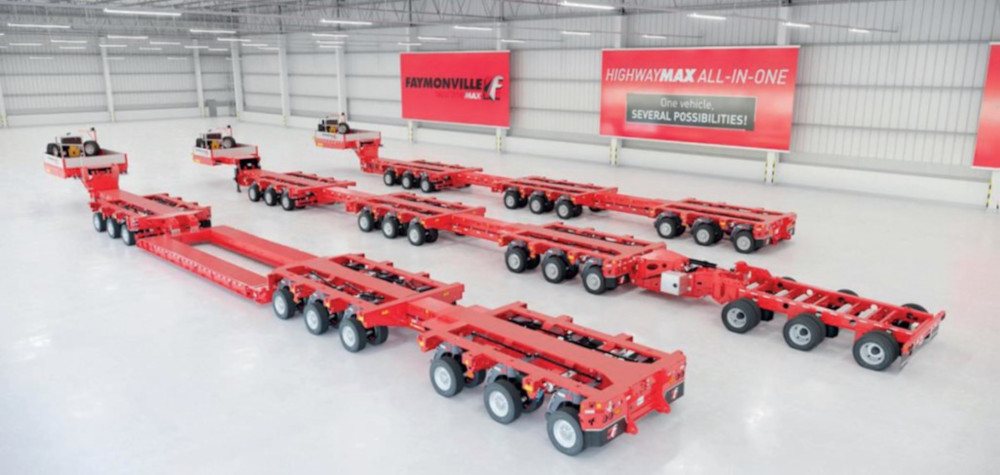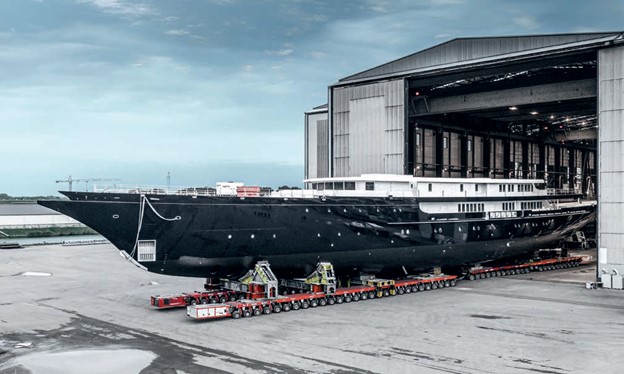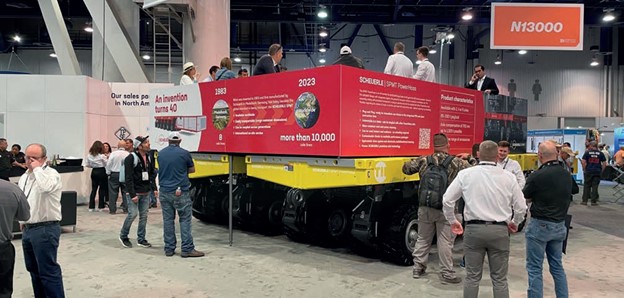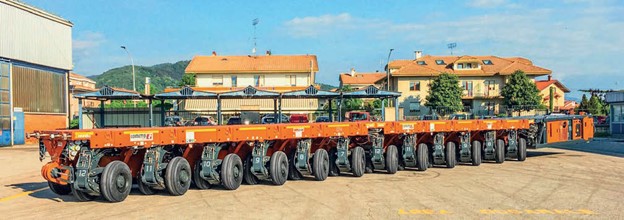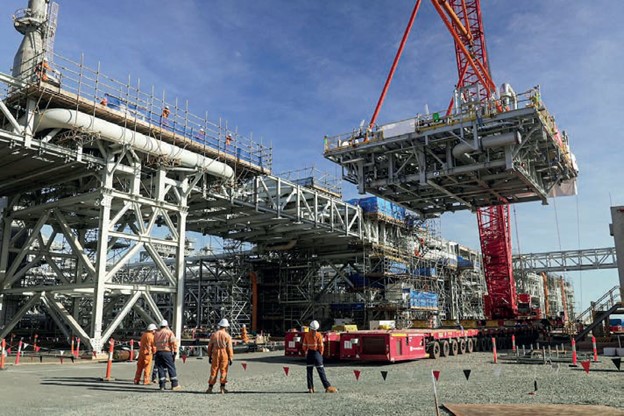Propelled to success
25 October 2023The SPMT has become the default machine for moving very large and heavy objects. Everything from boats to oil platforms to infrastructure are grist to their mill. Julian Champkin reports.
It is exactly 40 years since the first of these innovative vehicles was seen, moving slowly but surely carrying their heavy loads. The machines look amazing, with multiple wheels all aligned, and deceptively simple, too: a flat deck on which to put the load; wheels underneath to take the weight. A lot of unseen technology, however, goes into them.
TII Scheuerle – then known as Scheuerle Fahrzeugfabrik – introduced the first SPMT. In fact, the company lays claim to coining the name. The concept emerged from a need of its long-term customer Mammoet, which needed a modular platform transporter with a width of 2,430 millimetres to move loads with a standard flat rack container in the shortest possible time and as economically as possible. The modules needed to be able to go to the most remote locations worldwide, and be transported on land on motorways.
That was back in 1983 and the SPMT is now celebrating its 40th anniversary. Since then, the self-propelled modular transporter – let’s give it its full name, as a birthday present – has become the default for specialised heavy transport. Tens of thousands of Scheuerle axle lines are now in use around the world.
The man behind the idea was Willy Scheuerle, grandson of the founder of the business, which had begun as a simple forge in 1869. The technical basis of the machine was, as now, the hydraulically supported oscillating axle – which Willy Scheuerle invented as early as 1956 – combined with electronic multidirectional steering for heavy transporters. This was also an innovation by Willy Scheuerle, which he devised in 1972. He put the two together to form a flattopped module.
With the SPMT one or more Power Pack Units could be coupled to as many modules as needed to generate the energy for the hydrostatic travel drive, steering and lifting. The advantage was that single objects weighing even 1,000 tonnes could now be transported on land. Until then, they had had to be broken down into components of no more than 300 tonnes.
Now everything from oil rigs to complete hotels to Jeff Bezos’ yacht have been moved on them.
To mark the anniversary TII Scheuerle has introduced what you could call a conceptual upgrade to the SPMT. It is a telematics system which can be used on all SPMT vehicles. The company showcased it at Conexpo in February this year, using its PowerHoss 80 as a representative of the complete SPMT series.
The PowerHoss models are available with two, four and now also six axle lines, giving up to 80, 180 and 330 tonnes of payload per module. They can also, of course, be connected – in tandem or higher multiples – either mechanically or electronically, as well as being coupled to one another side-byside or longitudinally. So a vehicle combination of four PowerHoss 330s is able to move loads of up to 1,320 tonnes. Coupling is uncomplicated, based on plugand- play.
The pendulum axles give safe movement on surfaces ranging from concrete indoor areas through to gravel roads. That, with the 700 millimetres of axle movement in the pendulum bogies, means that reloading is not required when transporting from inside a building to the outdoors.
The telematics system is a digital monitoring and reporting network. If, for example, a filter becomes clogged or the filling level of operating equipment is too low, the vehicle automatically reports the need for a service. Dispatchers therefore have time to direct the vehicle to the workshop and at a time when it least disrupts daily work procedures and well before the unit should fail. TII Connect also opens up so-called Smart Services with intelligent analysis of vehicle parameters. In addition to predictive maintenance and service management, this gives a wide range of options for data analysis and process comparisons – that is, business intelligence – along with condition monitoring. Profitability, of course, benefits.
Faymonville, too, has brought out what it says is a milestone. Heavy-load trailers, rather than SPMTs, are its business; but it has introduced the same modular concept into those, and has a new model: the HighwayMAX All-In- One, based on its globally popular modular CombiMAX.
A single set can be assembled as a 3+6 double drop combination, as an extendable single drop trailer with nine axles or – with an additional nitro booster – as a 12-axle vehicle. But – and here’s the clever bit – it can also be configured as a tower adapter vehicle for the wind power industry. And wind, as we know, is currently a major player in the demand for heavy moves.
“The entire range such as excavator decks, perimeter decks and so on can be integrated in the double drop version,” says Faymonville product manager Rainer Noe. “Conversion to any of these versions is quick and easy.”
Interfaces on the front and rear bogie allow the fast exchange of components. “The basic idea for users is: define your transport task, then combine your vehicle to suit,” says Noe.
Industrial parts, construction machines, wind tower segments, crane elements and other heavy loads can be moved throughout North America on this innovation.
“The modular design provides haulage companies with more usage possibilities from just one vehicle concept,” Noe surmises.
DOWN UNDER
In 2022 Italian lifting and transportation specialist Fagioli formed a joint venture with Australian construction and engineering company Monadelphous. Named Alevro, the joint venture aims to bring more lift and shift expertise and capability to Western Australia.
The JV has secured a contract with Bechtel to deliver heavy haul and heavy lift services at the Pluto Train 2 Project in Karratha, Western Australia, which is the expansion of the existing Pluto LNG facility by adding a second gas processing train, as well as plant modifications and additional domestic gas infrastructure.
The infrastructure for the project includes some of the largest modules to arrive on Australian shores. They weigh up to approximately 4,500t apiece, and Alevro is responsible for receiving them, transporting them to the project site and then lifting them for construction.
Heavy load modules and self-propelled modular vehicles manufacturer Cometto, part of the Faymonville Group, is also involved in Australia and has just supplied MSPE modules to Monadelphous. It’s the second SPMT delivery this year and increases Monadelphous’s capacity by an additional 54 axle lines of MSPE 48t, four Power Pack Units 368kW and accessories including a 8,400 mm long loadable spacer. The company now has over 100 Cometto SPMT lines, having received 52 axle lines already in 2012.
Cometto has also recently dispatched the first consignment of 96 axle lines of its MSPE Evo3 SPMTs to the Australian navy. The model can carry 70 tonnes per axle line, which Cometto says is the highest value available on the market. The recipient is Australian Naval Infrastructure Pty (ANI), which effectively means the people who build the navy’s boats. ANI already has 120 axle lines in use to move heavy ship sections of large state-of-the-art naval vessels under construction.
“The new supply includes two Power Pack Units with an output of 368 kW each,” says Alberto Di Stefano, Cometto’s export area manager. “The complete delivery will give ANI the ability to enforce its total payload capacity of more than 14,000 tonnes to ensure the manufacturing of the future generation of surface ships and submarines.” The 70 tonne payload per axle line allows the ship builder to keep the self-propelled combination as compact as possible in moving between the different construction steps of the ships.
With the versatility and efficiencies the SPMT offers, it’s no wonder the machines have become indispensable for moving heavy and oversized objects worldwide.
And with the continuous improvement of the technology behind them new milestones are being marked; the SPMT will surely continue to play a crucial role in the movement of massive objects and infrastructure worldwide for the next 40 years.
skidding a still standing stack!
Fagioli was called on for a challenging vertical operation, near Milan, for the relocation of a brick chimney. The structure has a base diameter of 3.2m and is 33m tall. The height, slenderness and fragility – brick is not known for withstanding tensile stresses, so any bending forces on the chimney would not have been a good idea complicated the operation somewhat. Fagioli’s engineering department came up with a method: they used four skid shoes, on skid tracks, moving a tailormade support frame that connected to the chimney tower at its base. The operation perhaps looked bizarre but was safely and successfully carried out.
can you dig it?!
One of the largest civil engineering projects in Europe will be the second or third longest underground railway connection in the world when it is finished, depending on how soon its competitors reach completion.
It is the rail tunnel currently being built beneath the Brenner Pass in the Alps. (The competitors are also under the Alps: the Gotthard Base Tunnel in Switzerland, and the Mont D’Ambin Base tunnel between France and Italy.)
The Brenner Base Tunnel will be 55 kilometres long, and at its deepest is 1,720 metres below ground (which is just over a mile, if you think in those terms.)
It will greatly ease transport between Austria and Italy which, at present, goes mainly by road over the Brenner Pass. This road is high, steep and notorious for its traffic jams and the accompanying pollution (exacerbated by the steep-sided valley through which the road runs).
The scale of the project can be judged by its timescale: construction began in 2008, and opening is scheduled for 2032.
A succession of huge tunnel boring machines (TBMs), 7.8m in diameter – as large as the excavated tunnel itself - are driving their way through the dolomite rock. Felbermayr began transporting two new tunnel boring machines to the site at the start of this year. However, driving the components - weighing in at up to 270 tonnes - through sometimes very steep and narrow tunnels to the assembly caverns and assembling them on site proved extremely complex.
The stretch from the temporary construction site south of and above Innsbruck to the assembly caverns is only just under six kilometres long, but the route is tough. It runs entirely in tunnels, three kilometres of which have a gradient of up to 12 percent; and the roads are wet, making traction difficult.
"We used self-propelled SPMT units from Scheuerle with six, ten or twelve axles for these transports,” says project manager Markus Meusburger, of Felbermayr transport and lifting technology in Lauterach. “12 of them were used for the largest pieces of 270 tonnes. Those were the two drive components; they have a diameter of 7.8 metres – the same size as the tunnel they will excavate.”
These drives had been pre-assembled on the factory floor. "With a total weight of almost 300 tonnes and the steep gradient, we reached the mathematical limit of the brakes, so in order still to safely carry out these transports we used a four-axle heavyduty tractor as an additional braking vehicle," continues Meusburger. "It took us roughly three hours to cover the first three kilometres with the steep gradient, and five hours to complete the entire route."
Each TBM required about 30 transports to bring all of its components to the face. The journey entailed negotiating narrow passages. “Manoeuvring with centimetre precision was necessary in these areas, and that was probably the greatest challenge," says Meusburger. Some components of the tunnel boring machines were less heavy but bulky. "Parts of the so-called trailer are 15 metres long, 4 metres wide and 4 metres high. Because it was very narrow towards the tunnel ceiling, one employee spent fi ve hours sitting on the load in order to precisely instruct his colleague who was driving the self-propelled unit."
As well as these special transports there were countless trips for small parts and assembly material in smaller vehicles.
Once inside the large assembly caverns, the parts were unloaded and rotated into their assembly positions using a 1000 tonne lifting frame from the Felbermayr subsidiary Wimmer Maschinentransporte. The individual parts were gradually assembled into a large complete unit. Each of the two identical tunnel boring machines weighs 2,000 tonnes complete with the trailer – which itself includes entire infrastructures for the transport of excavated material, transformers, electrics, water pipes, compressed air and support material.
These were technically demanding assemblies, planned and implemented by the Felbermayr Engineered Solutions division.
Felbermayr had also been awarded the delivery contract. "From the manufacturer Herrenknecht in Schwanau in Baden- Württemberg, 97 road transports were required for a single tunnel boring machine alone, and a further 30 for the trailer which was produced in Slovakia," explains Meusburger. "That was a massive undertaking." The entire transshipping of the parts on the construction site was carried out with heavy-duty cranes in various sizes, coordinated by Felbermayr. Lift trucks and working platforms were also put to use.
At the end of May Felbermayr completed the project with the transport of two locomotives, which weighed in at around 40 tonnes and were transported by SPMT from the construction site installation area to the underground transfer point. The locomotives supply material for the TBMs.
As you would expect, required careful preparation well in advance. "We were able to fi x the project with the client at the end of 2022," says Meusburger.
Incidentally, this was not the first time the Felbermayr team had worked on the Brenner Base Tunnel: "We previously delivered a smaller tunnel boring machine for the exploratory tunnel in 2015 and transported it to the cavern."

